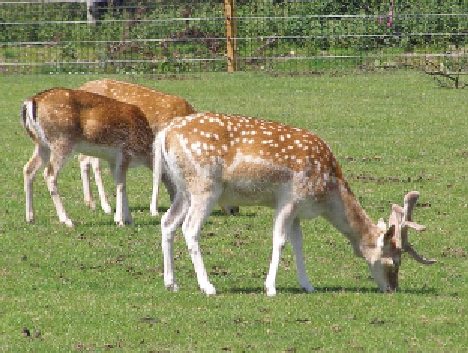Agriculture Reference
In-Depth Information
Judgement
Provided the condition is satisfactory,
carcases may be passed for human consumption.
Guidelines on contamination, missing viscera
and trimming
Contamination
Rabbit meat, carcases and/or offal affected with general
contamination by faecal material, bile, grease, disinfect-
ants, etc. should be considered unfit for human consump-
tion. Where contamination of the carcase is localised,
affected parts should be trimmed.
Missing viscera
Carcases presented with no viscera should not be passed
as fit for human consumption.
Figure 11.1
Fallow deer.
Trimming
Trimming must be carried out under the supervision of
the inspectorate. The selection of lesions or parts which
require trimming must not be delegated to the manage-
ment of the slaughterhouse.
Minor blemishes or bruising may be trimmed at the
inspection point.
Trimming of more serious conditions involving infec-
tion, for example, septic wounds or moderate contami-
nation by intestinal contents, is usually impractical with
high line speeds, and in these cases, an adjacent trim-
ming area should be provided.
Trimming of carcases may be delayed until after chill-
ing provided that:
1
The carcases are segregated and remain identifiable.
2
There is no risk of contamination of other carcases.
3
Trimming is done under the constant supervision of
an inspector.
weaned in September, to be finished in lowland units.
There is much interest in vertical integration, with many
farmers rearing deer and slaughtering them and selling
venison on the same premises. Some 60% of farmed ven-
ison is sold through farm shops after killing in the field
with a rifle.
Value-added products such as roasts with a fat cover-
ing, cubed venison for stews, venison burgers, mince,
haggis and sausages are being produced.
Handling and slaughter
Deer can be shot with a large rifle at very close range as
they stand, unsuspecting, in a field; this has a strong wel-
fare appeal. This should be undertaken, preferably by the
regular stockmen, when deer are quiet, as will occur at a
selected regular feeding site when they are being hand-
fed. Under such circumstances, it may be possible to
shoot 10 or more deer from a large group before the
remainder become unduly disturbed. Alternatively, they
can be killed in an ordinary abattoir after transport, and
this appears to work well with red deer. A third slaughter
option is on-farm abattoir.
Successful handling of deer depends upon under-
standing of their behaviour. The dominance hierarchy
is very important to deer, and handlers must maintain
their respect in order to avoid being the object of
aggressive behaviour. It is important to be calm, confi-
dent and competent. Aggression can take the form of
foreleg and hindleg kicks, and male handlers are
advised to wear a cricket box or similar protection.
Shields may be helpful. Stags in rut should be treated
with extreme caution. Regular contact with handlers
raises the fear threshold of deer and shortens their
flight distance.
Red deer should be deantlered (not while in velvet)
about 5 weeks prior to slaughter.
Most trimming should be carried out by staff supplied
by management. The mode of trimming may be adapted
to suit the requirements of management, providing that
all affected parts are removed. Care should be taken to
ensure there is no unnecessary wastage.
Farmed deer (Fig. 11.1)
In New Zealand where one in eight farms now produce
deer (there are more farmed deer than cattle), velvet ant-
ler is harvested and is worth more than the carcase. This
is illegal in the United Kingdom.
Eighty per cent of New Zealand deer production is
exported to Europe, with Germany taking up to 50%.
Deer are suited to a variety of management systems,
and stratification of the industry is becoming apparent.
Many hill farmers sell, in October and November, calves

